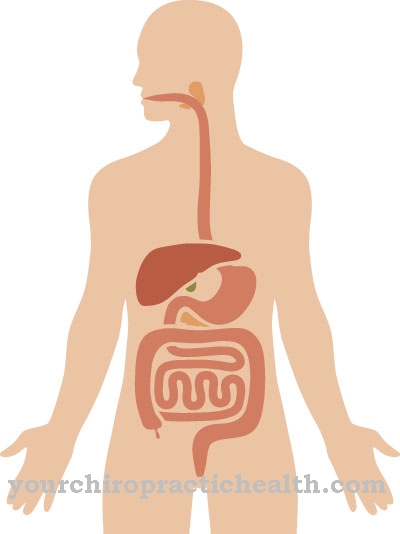The accumulation of lymph fluid in the chest is called Chylothorax designated. The lymph fluid collects between the lungs and the chest wall. This happens as a result of various other illnesses and causes breathing difficulties.
What is chylothorax?

© joshya - stock.adobe.com
A chylothorax is not an independent disease. It rarely occurs. It is a consequence of an injury to the breast milk duct. The causes of the damage usually include accidental injuries, medical interventions or tumors of the lymph vessels. In addition, the chylothorax can also develop after a birth trauma.
The chylothorax is a special form of pleural effusion. Here, the lymphatic vessel, the thoracic duct, is damaged and suffers one or more leaks. This violation of the so-called breast milk duct means that the lymphatic fluid can no longer flow back into the blood system. As a result, the fluid accumulates in the area of the pleural cavity undiminished.
The slit-shaped body cavity between the two sheets of the pleura is called the pleural cavity. The lymph fluid is the chyle, a fatty lymph from the human digestive tract. Under normal circumstances it flows independently into the venous blood via the thoracic duct. The chylothorax leads to dyspnoea. These are breathing difficulties caused by breathlessness or shortness of breath.
causes
The causes of the chylothorax are diverse. Most often it occurs in cancer. This can be caused by a malignant tumor of the lymph vessels or the surgical relocation of the thoracic duct as a result of a tumor. Furthermore, a chylothorax can be caused by injuries during an operation.
Unintentional damage can occur during a surgical procedure, for example on the esophagus, the chest, the mediastinum, the aorta or the heart. The mediastinum is a tissue space in the chest cavity. Chest drainage tubes or the laying of a central venous catheter can also damage the breast milk duct in the patient.
The chylothorax can also suddenly appear as a spontaneous rupture in the thoracic duct. Furthermore, trauma such as a blunt chest trauma can be the cause of the damage. In some cases, chylothorax has been diagnosed in patients with Gorham-Stout syndrome.
If the pleural effusion occurs in the first few days of life, it is mostly a malformation of the thoracic duct or trauma from childbirth. In rare cases, cirrhosis of the liver or the infectious and worm diseases filariasis can lead to a chylothorax.
You can find your medication here
➔ Medication for shortness of breath and lung problemsSymptoms, ailments & signs
The patient's breathing problems arise due to the accumulated lymphatic fluid. Adults with a fluid volume of about two liters or more can cause significant symptoms. Cough and chest pain are the first signs. The increase in fluid displaces the lungs and mediastinum.
Symptoms of chylothorax include indicators such as shortness of breath and an increased heart rate. At the same time, respiratory insufficiency and an increased breathing rate can occur. In addition, decreased or absent breathing sounds are detected in the patient. A test by performing and determining the knocking noise leads to a damping at the relevant point.
The loss of lymph leads to an overall reduction in the number of lymphocytes in the blood. In the case of infants, care should be taken to ensure that they are no longer fed with breast milk if they have a chylothorax. The reason for this is that the fatty lymph fluid accumulates in the chest cavity and the fatty breast milk additionally intensifies this process.
Diagnosis & course
There are several ways to diagnose chylothorax. Breathing and lung sounds are clinically observed and measured. In addition, the body surface is tapped. When x-raying the chest, a shadow can be seen in the pleural cavity. This is particularly the case in the deeper layers of the chest.
The lymph fluid can be removed by means of a puncture and its components examined in the laboratory. The liquid is milky and sterile. An increased fat content and a high protein content are measured. Since the body cannot remove the accumulation of lymphatic fluid in a chylothorax by itself, breathing becomes steadily worse. A spontaneous regression does not take place and a medical intervention takes place.
When should you go to the doctor?
If you experience breathing difficulties, coughing and chest pain, you should always consult a doctor. These complaints do not always indicate a chylothorax, but they must be clarified in any case. If there is a specific suspicion of the condition, it is best to consult a specialist in lymphology directly. If you have fears or panic attacks, you should go to the nearest clinic. Parents who suspect their child has a chylothorax or other condition should speak to their pediatrician.
Since the disease can be particularly severe in infants, a medical examination and treatment is essential. Patients who have had cancer or have had surgery on the esophagus, chest, aorta or heart are also particularly at risk. If the warning signs mentioned appear shortly after a surgical procedure or a tumor disease that has been overcome, the responsible doctor must be informed. A chylothorax must always be treated in the hospital. Sufferers are advised to undergo regular examinations after therapy in order to rule out any complications.
Doctors & therapists in your area
Complications
In most cases, chylothorax has difficulty breathing. These can sometimes lead to death. However, the possible complications and other complaints strongly depend on the cause of the disease. Often there is severe chest pain or a cough. The cough can also be bloody in some cases.
The patients suffer from shortness of breath, which can lead to a panic attack in many of those affected. This increases the heart rate, which in the worst case can lead to respiratory insufficiency. Often there are also pathological or absent breathing noises. If the chylothorax is not treated, it usually leads to death, with many patients also dying from the consequences of the disease.
The death rate is particularly high among young children and infants. The treatment itself aims to reduce the flow of Lyphph. However, surgery may be necessary if symptoms do not improve. If there are no errors during the procedure, there are usually no further complications. With early and correct treatment, life expectancy will not change either.
Treatment & Therapy
Medical treatment for a chylothorax is essential. Since untreated patients can die of a chylothorax, it is also a very serious disease. About 50 percent of the sick die as a result of the complications. The rate is significantly higher in infants.
The form of therapy depends on the cause of the chylothorax. There is no single form of treatment. A special diet is usually prescribed to reduce the possibility of fat build-up. If possible, the chest is relieved and the course of the accumulation is observed.
A targeted reduction of the lymph flow can lead to a closure of the lymph leak. In this way, the chylothorax can heal without further measures. However, if there is no regeneration, an operation will follow after about one to two weeks. An operation is also carried out in the event of a significant deterioration in health.
The thoracic duct is repaired and the leaks are closed again by sewing. This prevents any further leakage of the lymph fluid and the body can then independently return it to the blood system.
Outlook & forecast
If the chylothorax is recognized and diagnosed in good time, there is a good prognosis with immediate treatment. Since the chylothorax is mostly a secondary symptom as a result of another disease, the patient is often already receiving inpatient or outpatient treatment. Therefore, a good prerequisite is given that the chylothorax is discovered shortly after its occurrence and treated competently.
In addition, the patient's cooperation in the recovery process is one of the decisive factors for the success of the healing process. Many patients follow a special diet during treatment that must be adhered to. If this does not succeed, the chances of recovery worsen. The general state of health of the patient is also decisive. Since surgery is often required to treat the chylothorax, the patient needs physical resources to be able to overcome all the stresses and strains.
Overall, the chances of a cure decrease significantly as soon as the first complications have occurred. Around half of all patients die from other complications. In infants and small children, the death rate is also significantly higher. In patients who have already been cured, the experiences can also lead to a mental disorder. Anxiety disorder, personality disorder, behavioral problems or panic lead to years of impairment and considerably reduce the patient's quality of life despite physical improvements.
You can find your medication here
➔ Medication for shortness of breath and lung problemsprevention
Preventive measures cannot be taken with a chylothorax because it is a secondary disease.
You can do that yourself
The disease gives the person affected little room for maneuver to bring about relief or healing of the symptoms themselves. Nevertheless, he has the opportunity to promote the healing process and, if he is well aware of himself, to pass on changes to the doctor in good time.
As soon as the person concerned has the feeling that something is wrong or that they have unusually little air, they should trust themselves and get medical help. During all physical movements, care must be taken that there is no overexertion and shortage of breath. In particular, engaging in intense sports or strenuous physical activity should be avoided. In addition, physical activity should be reduced when the outside temperature is hot.
In order to live with the disease, it is helpful for those affected to have a stable social environment. Furthermore, a strong immune system is necessary in the healing process. A balanced and healthy diet, adherence to the ideal weight and participation in social life, taking into account the available options, are important.
This promotes wellbeing and, in addition, it strengthens mental health. Self-help groups or discussions with other sick people can also help to receive tips and hints on how to optimize and confidently live a life with the diagnosis.




.jpg)
.jpg)
.jpg)




















